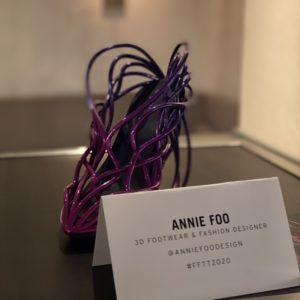Future Fashion Textile Technology Event – Interview with 3D Designer Annie Foo

Condé Nast College MA Student, Zoe Goetzman interviews 3D shoe designer, Annie Foo at the Future Fashion Textile Technology Event at the Sanderson Hotel, London on the eve of London Fashion Week.
Fashion will be customizable
“Fashion will be customizable,” predicts 3D shoe wear designer Annie Foo, when asked what the future of fashion will look like at last week’s Future Fashion Textile Technology event which took place at the Stratford Hotel in London, co-hosted by Hobs 3D, Women in 3D Printing, The Trampery and the Stratford. After the event, I sat down briefly with Foo to discuss her thoughts on 3D printing, sustainability, zero waste and customizable fashion.

About Annie Foo
Foo is a graduate of Central St Martins and the Royal College of Art. Her approach to sustainability is to use 3D printing as a new method with which she can, as she says, “push the boundaries” of fashion design, creating truly beautiful, complex and intricate works of art to challenge the overall conventional design process. As she explains,“3D printing is just a method. I like to challenge and push the boundaries [in terms] of the material and also the method of making.” At first glance, this way of thinking becomes immediately apparent when looking at one of Foo’s designs.
“3D printing is just a method. I like to challenge and push the boundaries…”
Annie Foo’s Process
For those unfamiliar with the process behind 3D printing (or for those who missed the Iris van Herpen highlights at Paris Fashion Week), such designs are created via a digital file and conceptualized through a designer’s computer screen. Once a design is complete, the designer can literally print out three dimensional garments or even objects via an on-demand, rapid and efficient production process.

Foo takes two principles into account when creating her designs: 1) durability and 2) visual appearance. First, she begins by taking a virtual scan of a person’s foot in order to obtain her client’s exact measurements. Second, she will craft a design around a virtual reality (VR) model. Third, once the design is finished, she will then print out the design, ensuring it’s custom-fit and comfortability.
Depending on the design’s complexity, Foo says that the entire design process can take up to “a few hours [or] one or two days.” However, if she is creating a whole new design from scratch, she reserves “a day” to think up an idea, highlighting the importance of craftsmanship over production speed.
Foo’s Approach to Sustainability: Put more energy into materials!
Annie Foo Design
3D Printing’s effect on sustainability
When asked if 3D printing could have a positive effect on fashion’s future sustainable landscape, Foo admits that this technology has its advantages, but, also suggests that people should start to reconsider how they consume and use materials. As she explains, “A lot of people say we have to stop using plastic. Can you imagine a world without plastic? It’s impossible. It’s just people are using it [the material] in the wrong way, so [the issue] has become worse.” In other words, to be truly sustainable means to find alternative solutions to the world’s wasted materials.
According to Foo, even the idea of zero waste fashion, or rather, a design philosophy adopted by designers such as Issey Miyake or Eileen Fisher cannot exist as long as designers keep putting energy into making clothes, “I don’t believe in zero waste fashion because [in] fashion,” she says, “[either way] you’re consuming [energy].”

Despite the innovative capabilities of 3D printing, this technology still has a long way to go before it can adapt to the same speed and accessibility of fast fashion brands. However, Foo is designing for a new type of consumer – one who craves unique, one-of-a-kind items and products, emphasizing the work of independent designers rather than commercial retailers. Her overall ethos and approach to sustainability not only urges people to minimise waste, but also advocates for more innovations to take place in the traditional design process, noting that the only solution to sustainability is to “spend and buy less,” urging people to find garments and shoes which are, as she details in her own brief write-up of her work and process, “perfectly fit.”
Words and images by Zoe Goetzman, MA Fashion Media Practice
Neil Moodie In Conversation with Anna-Marie Solowij at the Condé Nast College
